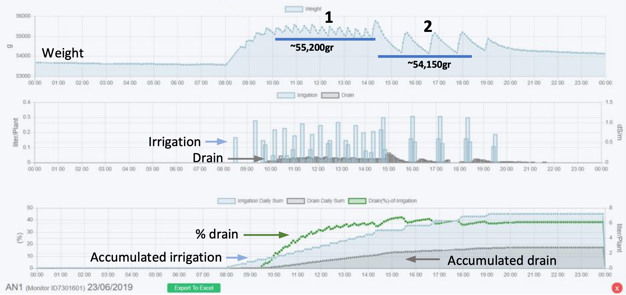To optimize the irrigation strategy growers must have a clear understanding of the moisture, drain and EC levels. Last week we published about how to improve the irrigation efficiency, today it is about the optimal conditions to be reached.
"Maintaining the optimal moisture conditions for crops growing in substrate requires a clear understanding of the substrate characteristics, the plant physiology, and the water uptake", explains Mr. Ziv Omer, DrainVision Product Manager & Agronomist with Paskal.
DrainVision, Paskal’s wireless irrigation monitoring system, provides a deeper insight into the drain performance and water availability, saving water and fertlizers while improving yield quality and quantity.
Variation among the crops
"Growing in different substrates with a limited volume, with different physical and chemical characteristics and water retention ability, variation among the crops, as well as rapid depletion of water and nutrients can potentially lead to plant stress", Ziv explains.
Therefore, to obtain an optimal water content in the substrate, an accurate and online water content monitoring is required.
"The most commonly used irrigation controllers in greenhouses are based on radiation measurement as it provides a good estimation of the transpiration. However, this practice may be too limited, as other factors effect the plant transpiration such as: humidity, temperature, greenhouse cover, plant variety, age of crop, substrate type and more."
Irrigation by fixed timed intervals is also a common practice, but requires additional attention, as drain needs to be sampled multiple times per day.
Close to the target
In some cases the daily percentage of the accumulated drain is close to the target level, but when using DrainVision one can follow more accurately the drain quantity, timing, uniformity and EC throughout the day.
"For example, if the timing of the irrigation is not precise, it can lead to over drain in the morning or afternoon and might cause lack of drain during the mid part of the day when transpiration is at its peak, causing fluctuation in the water content and EC level of the substrate, says Ziv.
Case Study of Blueberries
For optimum blueberry high yield production and quality fruits, accurate irrigation management is required.
"Water stress at critical times in the development of the blueberry plant can dramatically affect fruit yield and quality. However, blueberry plants under water stress may not show any visual signs of stress. Careful irrigation management is a key factor in achieving good yields and plant performance, and in the long-term plant health. Excess of irrigation on the other hand, reduces blueberry root function, increases nutrient leaching and enhances diseases such as Phytophthora", are the warnings.
"Implementing DrainVision in blueberry crops allow growers to achieve the optimal water content throughout the day, as well as cost savings on both water and fertilizers."
The following graphs represent the irrigation strategy in a Blueberry nethouse. In this case, two irrigation programs for the day have been defined by the grower;
- Shorter irrigation cycles and shorter intervals in the morning-early afternoon
- Longer irrigation cycles with longer intervals in the afternoon-evening
Program 1- Irrigation started at 8:00am, when water content was approximately 1,500 gr under its field capacity (55,136 gr). Field capacity was reached at 9:15am and from that point and on a stable water content was maintained until 2:00pm.
To provide constant water availability, when the transpiration rate is high, short timed irrigation cycles were programmed along with short intervals between the cycles. Drain performance remained uniform during this irrigation period, which allowed for constant leaching out and runoff of minerals.
Program 2 – Started at 2:00pm, characterised by higher irrigation volume with longer intervals between the cycles.
As seen in the graph, water content peaked at 2:00pm, which indicates a short interval before the first long irrigation. Since the irrigation cycles in program 2 had a volume of 610ml, with a target of 30% drain, the first cycle should have started 430gr below the field capacity and weight of 54,706gr (2:55pm). Subsequently, the lower water content that was maintained during this period also helped to promote root development, avoided root diseases, improved plant resistance to pathogens, and allowed for the runoff of minerals.
Dr. Guy Tamir, from the Agricultural Research and Development, Central Mountain Region, Israel, says that by using DrainVision, they now have the capability to adjust the irrigation practice of blueberry plants according to the water uptake and to determine the required leaching quantity. "In the near future we will also begin comparing the plants growth rate between different irrigation practices following the DrainVision data”.
Drainvision new Features:
DrainVision can be synchronized with other main irrigation systems that will allow for the irrigation to be operated automatically. Alerts are available in the application and will notify the grower when any of the measured parameters cross the defined thresholds.
For more information:
Ziv Omer, DrainVision Product Manager & Agronomist
Paskal Group 
Mr. Harel Dotan
[email protected]
Ziv Omer
[email protected]
www.Paskal-group.com

